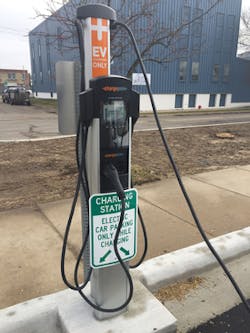Charge of the Utility-scale EV Brigade: A Chat with Consumers Energy's Sarah Nielsen
From coal-fired plant retirements to renewable energy projects, Consumers Energy is like many power generators eventually aiming for Net-Zero Carbon Emission goals. And, like many, it has faced skepticism around one key piece of the clean energy movement.
Electric vehicles. Sure, the skeptics say, GM and Ford and others can promise a complete overhaul to EV fleets, but we’ve heard this before. The EV charging infrastructure isn’t there, commercial fleet managers aren’t onboard and, most importantly, EV adoption is still relatively anemic in the U.S.
All true, perhaps, but Nielsen, who is Consumers Energy’s Executive Director of Transportation-Renewables and Storage, can attest to the gathering momentum of the eMobility movement in her company’s own service territory.
The three-year-old Consumers Energy initiative has made significant inroads, pun intended, with more than 200 Level 2 and 37 fast chargers installed in public spaces, and another 2,000 residential rebates for approved charger installments at homes and businesses.
“There’s an appreciation for how fast things are moving,” Nielsen said in exclusive interview with EnergyTech. “It’s crazy, and I can definitely feel that momentum. I can feel that on the fleet side, too, where it felt very far away five years ago.”
The transportation sector accounts for more than a fourth of greenhouse gas emissions in the U.S., according to statistics. Combined with commercial and industrial energy emissions, those three sectors are more than half of carbon pollution produced in the nation.
Consumers Energy has vowed to be a key player in reversing those statistics, which itself is remarkable considering the utility lies distinctly within the homeland of historic U.S. internal combusion automaker giants such as GM and Ford.
The utility’s three-year plan is a pilot which was extended for another two years. The new targets are another 100 Level 2 and 100 fast chargers in public areas, particularly in apartment complexes and hotels.
“Charging is going to be more predictable and centralized,” Neilsen said. “This helps us in terms of grid planning.”
Another key hurdle for truly impactful eMobility adoption are commercial fleets, whether that’s cargo trucking, mass transportation or light-duty vehicle electrification. The commercial electric vehicle (CEV) nut has been a hard one to crack, but Consumers Energy has been working to create more conversations with fleet managers to make it happen.
Nielsen said the utility’s PowerMIFleet program is proving effective in bridging the gaps, both communication and technology wise. Launched one year ago, PowerMiFleet seeks to get the conversations started.
“We have found the same thing: Fleet managers don’t often think about their utility when making decisions,” she noted. “So we pound the pavement, get out there and talk to them. Fleet managers may need to be incentivized to figure that out.”
PowerMiFleet (MI for Michigan) has gained funding for 50 fleet electrification assessments which companies can sign up for via Consumers Energy. The utility feels good about the response, with some 30 assessments completed, 15 more underway, and a waiting list for requests beyond the funded allotment.
“We’ve been really pleased with the interest” from a wide array of companies, Nielsen pointed out, including those in the government sector, education, retail and health care. “It’s quite a range of fleets which have raised their hands for this.”
The assessments offer a “treasure trove” of data useful to the utility, company and EV infrastructure planners. After all, it relies on a vulnerable grid and there are geospatial data challenges, switchgear, transformers and load anticipations to work out.
Getting the infrastructure right is “absolutely critical,” Nielsen said. “How do we support this rollout and do it in a way that benefits everyone?”
Consumers Energy’s eMobility goal is for hosting about one million EVs in its Michigan service territory by 2030. The utility also vows to be 60 percent renewables in its power generation resource mix by 2040.
In-house, the goal is to make 30 percent of its own, 6,000-vehicle operational fleet all-electric by 2030. Right now it’s slightly under 10 percent, with most of those light-duty trucks and company EVs.
“You got to walk the walk,” she said.
Overall, the road ahead is curvy and daunting but the utility is charged up and well on its way, Nielsen enthused. Consumers Energy serves the legacy home of the U.S. auto industry, and is encouraged by the automaker’s progressive achievements such as the new Factory Zero where GM is assembling new electric models.
So while Nielsen is a true believer in the EV Future, she also is agnostic about how they get there.
“We need to try every way,” she said.
-- -- --
(Rod Walton, senior editor for EnergyTech, is a 14-year veteran of covering the energy industry both as a newspaper and trade journalist. He can be reached at [email protected]).
About the Author
Rod Walton, EnergyTech Managing Editor
Managing Editor
For EnergyTech editorial inquiries, please contact Managing Editor Rod Walton at [email protected].
Rod Walton has spent 17 years covering the energy industry as a newspaper and trade journalist. He formerly was energy writer and business editor at the Tulsa World. Later, he spent six years covering the electricity power sector for Pennwell and Clarion Events. He joined Endeavor and EnergyTech in November 2021.
Walton earned his Bachelors degree in journalism from the University of Oklahoma. His career stops include the Moore American, Bartlesville Examiner-Enterprise, Wagoner Tribune and Tulsa World.
EnergyTech is focused on the mission critical and large-scale energy users and their sustainability and resiliency goals. These include the commercial and industrial sectors, as well as the military, universities, data centers and microgrids. The C&I sectors together account for close to 30 percent of greenhouse gas emissions in the U.S.
He was named Managing Editor for Microgrid Knowledge and EnergyTech starting July 1, 2023
Many large-scale energy users such as Fortune 500 companies, and mission-critical users such as military bases, universities, healthcare facilities, public safety and data centers, shifting their energy priorities to reach net-zero carbon goals within the coming decades. These include plans for renewable energy power purchase agreements, but also on-site resiliency projects such as microgrids, combined heat and power, rooftop solar, energy storage, digitalization and building efficiency upgrades.


